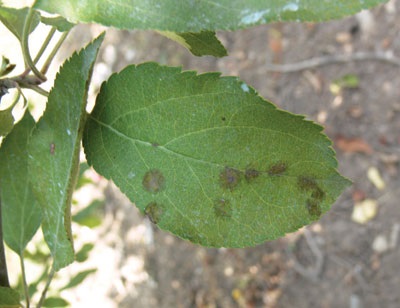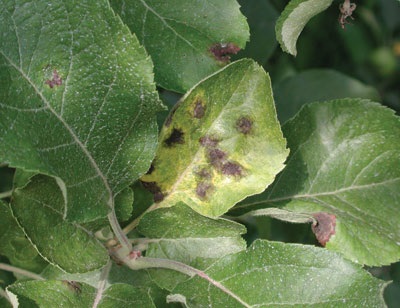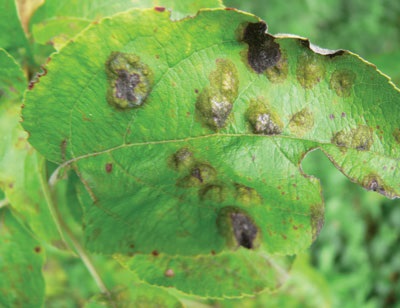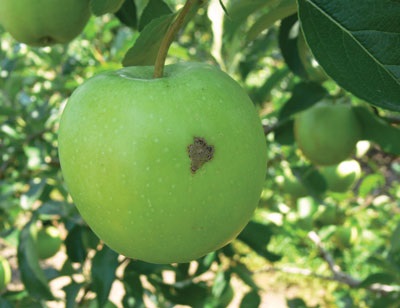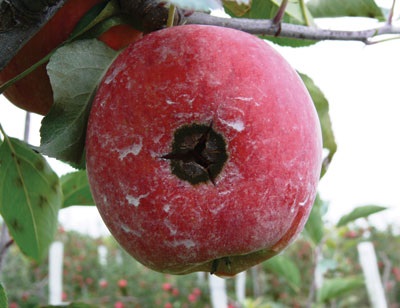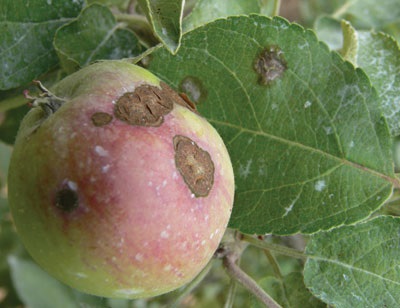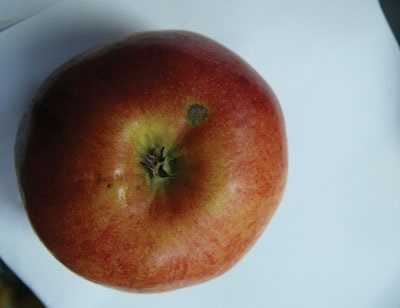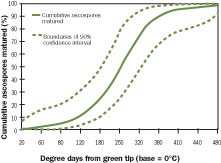Apple scab
Learn the biology, symptoms and how to monitor and manage apple scab.
Introduction
Apple scab, caused by the fungus Venturia inaequalis, is a serious fungal disease of apple in Ontario infecting foliage, blossoms and fruits. Severely infected trees become defoliated and infected fruit are not marketable. Apple scab also attacks flowering crab apples, mountain ash and firethorn.
Symptoms
Infection and subsequent lesion development occur on both sides of leaves, usually developing first on the lower side. On leaves, young lesions are velvety brown to olive green with indistinct margins (Figure 4-116) and are often not noticeable until after petal fall. With time, olive green lesions turn dark brown to black (Figure 4-117). The number of lesions on leaves varies depending on the season and variety susceptibility. Lesions on older leaves are typically raised, dark green to gray brown with distinct margins, and cause cupping on the underside of the leaf, (Figure 4-118). Leaves that are heavily infected with scab will curl, shrivel and fall from the tree.
Small black spots develop on fruit, enlarging more slowly than on leaves (Figure 4-119). As these spots grow and become older, the centre loses the velvety appearance and becomes brown, corky and scabby (Figure 4-120). Heavily infected fruit becomes deformed and cracked when infected at an immature stage (Figure 4-121). Fruit infections occurring late in the summer may not be visible at harvest to the naked eye, but enlarge in storage to pin-head size. These lesions are "pin point scab" (Figure 4-122). The entire fruit is susceptible to scab, but lesions tend to cluster around the calyx end of the fruit.
Biology
Apple scab overwinters in infected apple leaves on the orchard floor. During the winter and early spring, small black pseudothecia develop in the infected leaves on the orchard floor.
By early spring, ascospores which serve as the primary inoculum for early season infections are formed inside the pseudothecia.
Maturation of the ascospores in the dead leaves on the orchard floor usually occurs at the same time the apple tree is emerging from dormancy. Mature ascospores are present and ready to infect the first green tissue in spring. The percentage of mature ascospores in the orchard generally peaks when apples are at the late pink to early bloom stages of bud development.
Mature ascospores are discharged from the pseudothecia by rain and carried up to emerging green tissue in the trees by wind currents. Moisture — dew or rain — is necessary for ascospore discharge and germination, as well as subsequent infection of apple tissue. Olive green, velvety lesions appear 10-28 days after infection by an ascospore. The lesions initiated by ascospores result in primary infections, and in turn, produce spores called conidia.
Conidia are spread from primary lesions by splashing rain drops and wind, and initiate further infections when the combination of temperature and leaf wetness enables them to germinate and become established. These are called secondary infections, and generally occur within a tree or between adjacent trees rather than at a long distance.
The secondary cycle can be repeated many times during the growing season. With frequent rainfall, the control of apple scab becomes extremely difficult, particularly if the disease becomes established from primary infections in the spring.
Leaves are most susceptible to infection until they are fully expanded. Old leaves may again become susceptible to the fungus in late season, and previously inhibited mycelia inside the leaf tissues may resume growth, resulting in new visible lesions. This phase of epidemics in autumn has significant implications for disease management because it provides additional primary (ascospores) inoculum next spring.
Monitoring and management
Monitoring weather
Accurate weather data provides daily maximum and minimum temperatures, a necessary component in using the degree day model for assessing ascospore maturity and primary infection (described below). Reliable weather monitoring equipment in the orchard is a good investment. Various computerized weather instruments and software are commercially available. These measure temperature, relative humidity, leaf wetness to indicate ascospore maturity and when infection periods have occurred.
Determining the inoculum level
The incidence of fruit scab at harvest does not necessarily reflect the disease pressure in the orchard, since foliar infections continue to occur after harvest. To predict the amount of inoculum in the orchard in spring, assess the leaf scab present in the fall (Potential Ascospore Dose, or PAD). In late September or early October, before leaf fall, assess for foliar scab using the following technique.
Select a sampling scheme to sample every 10–30 trees, making sure trees are selected throughout the block. Be sure the total number of shoots examined equals 600. Here are three sampling schemes:
- 20 shoots on each of 30 trees (a block of 300 to 900 trees) or
- 15 shoots on each of 40 trees (a block of 400 to 1,200 trees) or
- 10 shoots on each of 60 trees (a block of 600 to 1,800 trees)
Use the following procedure to sample.
- On each selected tree, examine shoots at random from the top, bottom, inside and outside of the canopy. It is particularly important to include shoots near the top of the tree. This is where scab is more likely to occur due to greater chance of poor spray deposition. If sucker shoots are common, include one sucker shoot per tree.
- On each selected shoot, scan the upper and lower surfaces of the leaves and record the number of leaves with one or more scab lesions, including spots where scab lesions is suspected.
- Total the number of scabbed leaves recorded.
- If the number of scabbed leaves is 50 or less: Assume the orchard has a low inoculum level for the next season. The first fungicide spray for apple scab can be safely delayed until as late as tight cluster.
- If the number of scabbed leaves is 50 to 100: Where inoculum assessments in autumn show less than 53 infected leaves per 600 shoots, green tip spray can be omitted in most years. This strategy is risky for orchards where apple scab is resistant to dodine and DMI fungicides because no fungicides with pre-symptom activity are available to compensate for any errors. Select a sanitation program, perform the selected practices and assume the orchard has a low inoculum level for the next season.
- Caution — if the number of scabbed leaves is greater than 100: The amount of inoculum in the orchard is high. Maintain a protectant fungicide program beginning at green tip the following season.
Do not use PAD under the following conditions.
- If DMI fungicides (Nova/Nustar) have been applied that season, particularly when used for after infection activity. Scab lesions are inhibited, but not killed, by these fungicides and this inhibition has shown to break down in the fall. These lesions cannot be detected in the fall when doing PAD sampling.
- If there are scabby, wild trees which contribute inoculum within 200 m of the orchard perimeter.
Determining apple scab infection periods
Primary infection periods
Once the tree breaks dormancy and green tissue is present, a primary infection occurs if the following three conditions are met:
- mature ascospores are present in leaf litter in the orchard
- weather conditions favour ascospore discharge and infection
- fungicide protection is inadequate to prevent infections
Mature ascospores are always present in infected overwintering leaves at bud break. The number of ascospores present depends on the amount of inoculum in the overwintering leaves. The rate ascospores mature in the overwintering leaves on the orchard floor is mainly determined by temperature.
Researchers at Cornell University have developed a model relating temperature to ascospore maturation. The model is expressed in degree days Celsius (or DDC) and predicts the percentage of the season's ascospores that have matured. The model is useful for describing the beginning, peak and end of ascospore maturation in general terms - but unusual weather conditions may contribute to significant ascospore discharges earlier or later than the model predicts.
For further information, see Figure 4-123 Cumulative percentage of ascospores matured at various degree day accumulations. Daily accumulated degree days are calculated as follows:
DDC = (maximum °C + minimum °C) ÷2) - 0°C
For example, on a day with a high of 10°C and low of 2°C, accumulated degree days are 6 DDC. If either of the daily temperatures are below 0°C (i.e. a negative number) use a value of zero for that temperature. Begin degree day accumulations at bud break - the day when at least 50% of fruit buds on McIntosh are between silver tip and green tip.
Use the degree day accumulations to estimate percentage of mature ascospores from the central curve in Figure 4-123. The upper and lower curves are the upper and lower 90% confidence limits around the estimates on the graph. The estimate must fall within this range 90% of the time.
There are two points of particular interest on this graph:
- At 125 DDC, there is a rapid maturation of ascospores that indicate higher risk of infections.
- At 418 DDC, more than 95% of the ascospore supply are depleted if sufficient rain has occurred. See Table 1. Percentage of mature ascospores discharged under various environmental conditions. This marks the end of the primary infection season. Use this model to obtain a site-specific forecast of ascospore maturity and discharge for individual orchards.
| Type of rain event | % of mature ascospores discharged |
|---|---|
| Night rain only | 5% |
| Day rain <0.25 cm; <10°C | 25% |
| Day rain >0.25 cm; <10°C | 50% |
| Day rain <0.25 cm; >10°C | 50% |
| Day rain >0.25 cm; >10°C | 90% |
Ascospores are released when there is rain to wet the pseudothecia in the dead leaves. Most of the available mature spores are discharged within two hours after the start of rain. Ascospore release is light dependent and only a small percentage of available ascospores are released at night from 7 p.m. to 8 a.m. Eastern Daylight Savings Time (EDST). Under most circumstances, more than 95% of available ascospores are not released until after sunrise when rain begins after sunset. It is safe to assume that in low-inoculum orchards (as defined above), primary infection periods begin at dawn when rain begins at night.
Ascospores are not released to any significant extent during nighttime hours in low inoculum orchards. In an orchard where ascospore inoculum is high — although percentage of ascospores released is small — the total number of ascospores released is large and can result in a significant primary scab infection. However, secondary spores (conidia) are not affected by light or darkness. Do not ignore wetting hours during darkness if scab infections have already been observed in the orchard or if not certain of excellent control for all previous infection periods.
In a low-inoculum orchard, calculate the length of the wetting period using the following method:
- when rain begins during the day, between 8:00 a.m. and 7:00 p.m. EDST, count the hours of leaf wetness from the first hour rain was recorded until the leaves are dry
- when rain begins at night, between 7:00 p.m. and 8:00 a.m. EDST, count the hours of leaf wetness from 8:00 a.m. until the leaves are dry
For a high-inoculum orchard, calculate the length of the wetting period from the start of the rain until the leaves are dry, regardless of the time of day.
Rainfall is needed for the release of ascospores, and leaves and fruit must be wet for infection to occur. The length of the wetting period required for infection varies with temperature. This relationship between hours of wetting and temperature is outlined in Table 4-4 Relationship of temperature and moisture to apple scab infection.
| Average temperature (°C) | Minimum number of hours of leaf wetness required Primary season (ascospore infection) | Minimum number of hours of leaf wetness required Secondary season (conidia infection) |
|---|---|---|
| 1 | 40 | 37 |
| 2 | 34 | 33 |
| 4 | 27 | 26 |
| 5 | 21 | 23 |
| 6 | 18 | 20 |
| 7 | 15 | 17 |
| 8 | 13 | 15 |
| 9 | 12 | 13 |
| 10 | 11 | 12 |
| 11 | 9 | 10 |
| 12 | 8 | 9 |
| 13 | 8 | 9 |
| 14 | 7 | 9 |
| 15 | 7 | 9 |
| 16 | 6 | 9 |
| 17 | 6 | 8 |
| 18 | 6 | 8 |
| 19 | 6 | 8 |
| 20 | 6 | 7 |
| 21 | 6 | 7 |
| 22 | 6 | 7 |
| 23 | 6 | 8 |
| 24 | 6 | 9 |
| 25 | 8 | 11 |
| 26 | 11 | 14 |
Adapted from: Stensvand, A., Gadoury, D. M., Amundsen, T., Semb, L., and Seem, R. C. 1997. Ascospore release and infection of apple leaves by conidia and ascospores of Venturia inaequalis at low temperatures. Phytopathology 87:1046-1053.
Once the length of the wetting period is determined, calculate the average temperature during this interval and check Table 4-4 to see if leaves were wet long enough for an infection to occur.
Secondary infection periods
Secondary scab infections occur when splashing rain spreads conidia, developed from scab lesions on leaves. As with primary infections, secondary infections occur only if moisture from rain is present long enough at a given temperature. Since secondary infections occur day or night, calculate from the beginning of the wetting period, regardless of time of day. Scab infection periods continue throughout the summer from lesions caused by conidia.
| Average temperature °C | Hours of wetting for 2% fruit infection (1 week after full bloom) | Hours of wetting for 2% fruit infection (5 weeks after full bloom) | Hours of wetting for 2% fruit infection (10 weeks after full bloom) | Hours of wetting for 2% fruit infection (15 weeks after full bloom) |
|---|---|---|---|---|
| 10 | 13.0 | 26.0 | 37.0 | 45.5 |
| 12 | 10.0 | 21.6 | 31.0 | 38.0 |
| 14 | 8.5 | 18.5 | 26.5 | 32.5 |
| 16 | 7.5 | 16.0 | 23.0 | 28.5 |
| 18 | 6.5 | 14.5 | 20.5 | 25.5 |
| 20 | 6.0 | 13.0 | 18.5 | 23.0 |
Adapted from: Schwabe, W.F.S., Jones, A.L., and Jonker, J.P. 1984. Changes in Susceptibility of Developing Apple Fruit to Venturia inaequalis. Phytopathology 74:118-121. Cultivars tested were: Golden Delicious, Starking Delicious, Starkrimson Delicious, and White Winter Pearmain.
Effect of intermittent rain and dew on infection periods
Periods of dew or high humidity (more than 90%) contribute to a wetting period, but are usually significant only if preceded by rain. Add together wet periods caused by intermittent rain to determine the length of an infection period, unless wet periods are separated by 10 hours or more of dry, sunny weather.
Fruit infection
As fruit matures, it takes a longer wetting period for infection by apple scab to occur. Table 4-5. Relationship of temperature, hours of wetting and weeks after full bloom to secondary apple scab infection of fruit, outlines this relationship.
The wetting periods required for infection of fruit by apple scab are longer than those required for leaf infection. For orchards with only light primary leaf infection - and where only fruit scab is a concern - base spray decisions on the longer infection times required for fruit. However, if unchecked during the growing season, leaf infection could create large amounts of overwintering scab inoculum and heavy ascospore release the next year.
Management of apple scab with fungicides
Fungicides are used to control scab in most commercial orchards. See OMAFRA Publication 360, Fruit Production Recommendations for information about the activity of different fungicides available for apple scab.
Protectant fungicides
Residues inactivate and kill fungal spores and prevent infection. These products are formulated to stick to foliage if it rains after the spray has dried. If it rains, a small proportion of residue goes back into solution and redistributes on tissue that was sprayed, but does not redistribute to unsprayed leaves or fruit. Coverage with these products must be complete, on both upper and lower leaf surfaces and the entire surface of fruit. Apply fungicides to expanding foliage when infections are imminent.
- Begin the program just before the first anticipated primary infection period between silver tip and green tip, and continue at 7-10 day intervals, using the shorter interval if frequent heavy rainfall or rapid shoot growth occurs. Protect new growth and expanding fruit, and replace residues washed off by rain.
- From first cover until early August, apply fungicides at 10-14 day intervals depending on rainfall frequency. The exception is when using DMI fungicides - use a seven day spray schedule regardless of rainfall.
Pre-symptomatic (after-infection) sprays
An after-infection spray is applied within a specific time after the start of an infection period. Time available to apply the fungicide effectively depends on the product used and average temperature. To calculate after-infection activity, count the time interval from the beginning of the infection period. For example, at 6°C apply Captan within 48 hours from the beginning of the infection period.
Do not rely on pre-symptomatic or after-infection fungicide programs to control scab. To use this spray program successfully, well-calibrated equipment that provides thorough spray coverage of leaves and fruit under adverse conditions is necessary. Reliable and accurate temperature and leaf wetness monitoring equipment is essential for each orchard.
Use of demethylation inhibitor (DMI) fungicides (sterol-inhibitors)
Nova 40 W and Nustar are members of demethylation inhibitors (DMIs) — a group of fungicides known as sterol inhibitors. These products are used differently than protectant fungicides such as captan or mancozeb.
The main strength of the DMI group of fungicides is their relatively long post-infection, pre-symptom activity. These products cure new scab infections if applied within 72-96 hours after infection. DMI fungicides, however, generally have only three to five days of protectant ability.
DMI fungicides must be absorbed by the leaf and fruit tissue to be effective. They are absorbed within one hour of application and efficiency is not reduced if rain occurs more than one hour after application.
DMI fungicides do not redistribute well after application, making uniform spray coverage essential for good disease control.
Do not use Nova 40 W or Nustar earlier than tight cluster. Apply in combination with a half rate of a protectant fungicide in blocks of two consecutive applications, 7-10 days apart. DMI fungicides are weak on fruit scab, so do not start a DMI program after bloom. Apply Nova 40W, or Nustar plus a protectant fungicide (e.g. Captan), within 72 hours after the beginning of a scab infection period. Do not stretch consecutive applications past 10 days. Apply at least two but no more than four sprays per season, preferably between tight cluster and first summer spray.
After a DMI plus a protectant fungicide application, leaves and fruit are protected for only five days. Apply a protectant fungicide before the next scab infection period. Follow up with a protectant fungicide program as required for the rest of the season. Also see fungicide resistance.
Use of strobilurin fungicides
Sovran and Flint 50 WG are members of the family of fungicides called strobilurins (or quinone outside inhibitors, QoIs). These products have good protectant and post-infection activity on apple scab and powdery mildew. Do not use Sovran or Flint 50 WG earlier than tight cluster, and apply in blocks of two applications, 10 days apart. Due to the mode of action of this fungicide group, it is important to carefully follow resistance management strategies. Use another chemical family for two applications before returning to either Sovran or Flint 50 WG. After an application of Sovran or Flint 50 WG, tissue is protected from infection for five to eight days. In conditions of rapid growth, shorten intervals between applications.
Some strobilurin fungicides are phytotoxic to other fruit crops (Sovran is phytotoxic to sweet cherries and Flint is phytotoxic to concord grapes). Always check the label for precautions.
Use of anilinopyrimidine (AP) fungicides
Vangard and Scala are members of the anilinopyrimidine family. These products provide good protectant activity against apple scab, but do not control other foliar or fruit diseases such as powdery mildew or cedar-apple rust. To manage apple scab, make no more than two applications per season and only at pre-bloom. Scala is registered for pre-harvest control of some post-harvest diseases.
Both Scala and Vangard are most effective under cool conditions and provide up to 48-72 hours of post-infection activity against apple scab. Results from research trials in the Hudson Valley, New York indicate these products provide scab control similar to mancozeb when used at the protectant timing, and superior control compared to mancozeb in a trial where short-term post-infection activity (<72 hr) was critical. The activity of these products is reduced in orchards with apple scab resistant to the DMI fungicide group.
Control of apple scab under adverse weather conditions
Several consecutive days of continuous wet conditions and mild temperatures are common in the spring — conditions that encourage apple scab infection. It is often difficult to maintain sufficient fungicide coverage on trees to provide protection for rapidly expanding foliage and fruit under such conditions.
If concerned about adequate protection, it is better to apply a fungicide with protectant activity during a break in the rain than to not spray at all. Use a fungicide with good retention properties — products with mancozeb such as Dithane, Manzate and Penncozeb have good retention activity.
After infection sprays are required when protectant fungicides become too diluted due to high rainfall to prevent the apple scab fungus from establishing itself on the foliage or fruit.
If an infection occurred, scab lesions become visible on the foliage and fruit in about nine days after the infection when the average temperature is 20°C — or in about 14-21 days if average temperatures are 12°C or lower. When scab lesions are present in the orchard, avoid using fungicides with high potential for resistance (DMIs, strobilurins) and focus on protecting uninfected tissue from further infections.
Strong winds hamper spray operations by causing pesticides to drift away from the intended target. Spraying during the evening or early morning when winds are light helps reduce spray drift. Lowering the spray trajectory into the wind also minimizes drift, but take extra care to ensure treetops get good spray coverage.
Secondary scab management
The end of primary season is determined through the degree day model. At 418 DDC, more than 95% of ascospores are mature and after a significant rain most of the ascospores have been discharged for the season. See Figure 4-123. After this point, wait two weeks before checking trees for scab. It may take up to 14 days for lesions to appear after a scab infection period. Be sure to check the tops of standard trees, the centre of a thick tree canopy or anywhere else spray coverage may not have been adequate.
If primary scab was controlled, lengthen the interval between sprays for the remainder of the growing season and reduce the rates of fungicides (with labeled rate range) to the lower rate. Some growers successfully eliminate all use of fungicides during the summer months where primary scab is controlled. If scab lesions are found, maintain a fungicide program for the remainder of the season.
Fungicide resistance
Several fungicide families available to apple growers are prone to the development of resistance, so fungicide programs must be developed to minimize this risk. Implement these strategies to avoid or manage the development of fungicide resistant scab populations in apple orchards.
- Always rotate among chemistries in a fungicide program. See products used on apples in OMAFRA Publication 360, Fruit Production Recommendations
- Never exceed the maximum number of applications listed in OMAFRA Publication 360, Fruit Production Recommendations.
- Always use full rates of DMI fungicides with a half rate of protectant fungicide.
- Do not miss fungicide sprays at green tip.
- Be prepared to spray, even in the rain if necessary, with Supra Captan, Maestro, Dikar, Manzate, Dithane, Penncozeb and Polyram but keep in mind residual control will be lost. Do not spray Nova, Nustar, Sovran, Flint, Scala or Vangard in the rain.
- Always apply fungicides preventatively before infection, not curatively after infection. The curative application of fungicides may encourage survival of fungicide-resistant populations.
- Always use full label rates of fungicides. Reduced rates increase the number of resistant individuals present in an orchard.
- Ensure complete coverage with the appropriate volume of water. Do not spray alternate rows.
- Do not extend spray intervals beyond those listed on the label. Shorten spray intervals in case of rain.
- Employ sanitation procedures to reduce overwintering inoculum.
Do not apply DMI (sterol-inhibiting) or Qol (strobilurin) fungicides when scab lesions are present as this encourages resistance to develop.
Orchard sanitation for high-inoculum orchards
The amount of inoculum in overwintering leaves is reduced by the following practices.
- Applying urea fertilizer at 45 kg/ha (mixed in 1,000 L of water/ha) after snow has melted but before bud break softens fallen leaves that may contain overwintering scab lesions. This stimulates leaf breakdown by microbes and promotes faster removal by earthworms that feed on them. Urea also directly suppresses ascospore formation. Treat the entire orchard, including the ground cover in the middle of rows. Apply urea spray using either an air blast sprayer with the upper nozzles turned off, or a boom sprayer set up to spray both under the trees and the middle of row. Reduce subsequent nitrogen fertilizer rates by the amount of N applied under the drip line of the tree rows. However, ignore the amount of N applied to the middle of the rows since it is utilized by ground cover.
- Shredding overwintering leaves in the spring with a flail mower stimulates decomposition and disorientates many of leaf pieces so they eject ascospores toward the soil, instead of up into the tree canopy. Keep the flail mower set low enough to contact the fallen leaves, and rake or blow leaves from under trees into the middle of the row, or offset the mower to reach them. Chop winter prunings at the same time. Lower mower settings required to effectively shred leaves may denude the middle of the rows, becoming muddy and slippery at the time when early fungicide sprays are required. Apply lime at 5.6 tonnes/ha in early winter after leaves have fallen from trees to raise the pH of the fallen leaves and increase rate of microbial breakdown.
